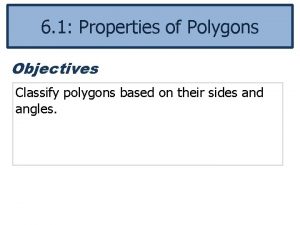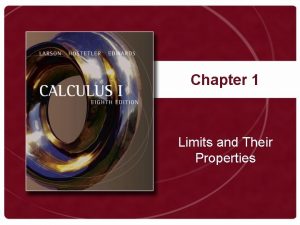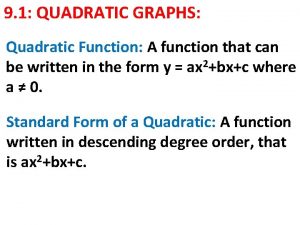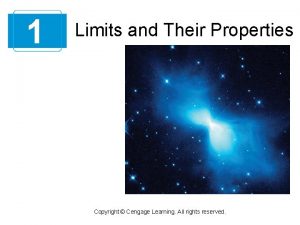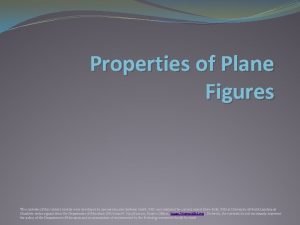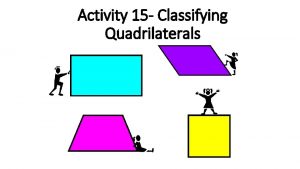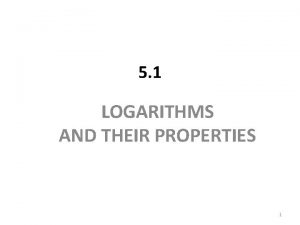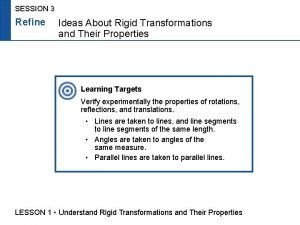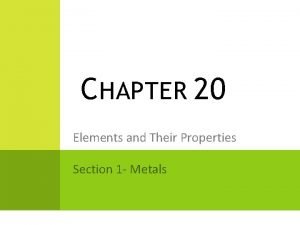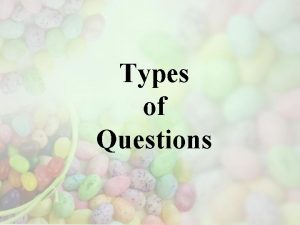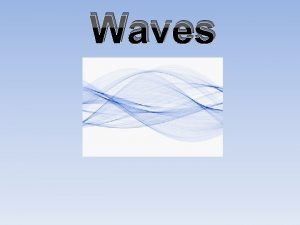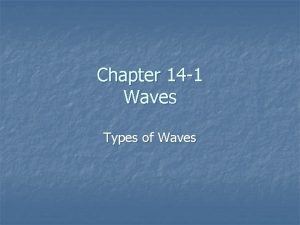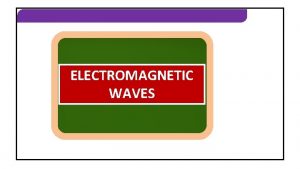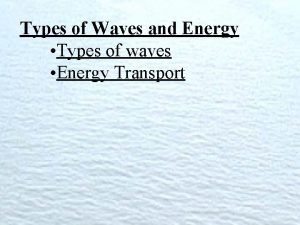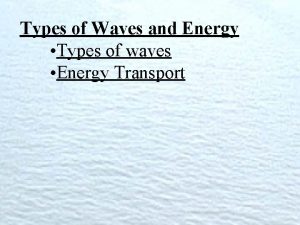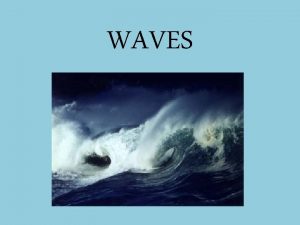WAVES Types of Waves and Their Properties Questions































- Slides: 31

WAVES Types of Waves and Their Properties

Questions of the Week �What is a wave? �What kinds of waves are there? http: //brightstorm. com/science/p hysics/vibration-andwaves/wave-characteristics/

Waves Are Everywhere!!! � Waves are disturbances that transfer energy through matter or space. � Energy is the ability to do work. � There are 2 main types of waves: � 1) Waves that require a medium to travel through � Waves that need a medium are called mechanical waves. � A medium is the material (matter) in which a mechanical wave travels. � A medium can be a solid, liquid, gas, or a combination. � All waves that travel through a medium have a source. � 2) Waves that are able to travel without a medium � � eg. electromagnetic (light) waves can travel through a vacuum (empty space where there is no matter), but can also travel through a medium We will learn more about EM waves when we talk about light later in the Unit. � Khan Academy – Introduction to Waves

Mechanical Waves � Mechanical waves are created when a source of energy causes a medium to vibrate or oscillate. � Vibrations are repeated up-and- down or back-and-forth movement of molecules or objects � Sound and water waves travel through a medium. � The medium requires matter � A medium can be a solid, liquid, gas, or a combination of these. � There are 3 types of mechanical waves, based on the direction the wave moves: � longitudinal, transverse, and surface �Vibrations Video #1

Transverse Waves � A transverse wave is when matter in the medium moves at right angles (perpendicular, 90°, or up and down) to the direction the wave travels. � eg. a rope, electromagnetic radiation (light), seismic waves (earthquakes) � The crest is the highest part of the wave. � The trough is the lowest point of the wave. � Rest is where the wave would be if it wasn´t moving (in the middle of the crest and the trough). � Transverse wave video � Brightstorm - Transverse Waves

Longitudinal Waves � A longitudinal wave (compression wave) is when matter in a medium moves in the same direction (parallel or back and forth) that the wave travels. � eg. slinky; sound � A compression is when the medium is pushed close together (or is more dense). � A rarefaction is when the medium is pulled farther apart (or is less dense). �Longitudinal wave video �Transverse vs. Longitudinal wave �Brightstorm – Longitudinal Waves

Types of Mechanical Waves

Surface Waves �A surface wave is a combination of the two types of waves (longitudinal and transverse). � The particles move in a circular motion. �It occurs between two mediums; for example air and water. �Water moves back and forth slightly but can not compress �Brain. Pop - Waves

Question of the Week �If waves are similar to one another, how can we tell them apart?

Properties of Waves � There are many different types of waves (eg. sound, light, etc. ), but all waves have the same basic shape � Waves share certain properties � What distinguishes one wave from another are: � The amplitude (height) of the wave � The wavelength (distance) of the wave � The frequency (number of waves in a certain time) � The speed (how fast) at which a wave travels � Khan Academy – Amplitude, Frequency, and Wavelength of Waves

Which Wave Has More Energy? �When you go surfing, do you try to catch: �A little wave… �… Or a BIG wave?

Amplitude �The amplitude of a wave is the height of the crest or the depth of the trough (they are the same). à In a transverse wave, amplitude is the distance from rest to crest (or rest to trough)… but not crest to trough! à In a longitudinal wave, amplitude is how compressed a wave is. � The larger the amplitude, the greater the energy a wave has. � The smaller the amplitude, the less energy a wave has. Which wave has the highest amplitude? � Amplitude video � Wave Characteristics video

Wavelength �The wavelength (λ) is the distance between two corresponding parts of the wave � eg. in a transverse wave, it is measured from crest to crest, or from trough to trough � eg. in a longitudinal wave, it is measured from compression to compression or from rarefaction to rarefaction � Wavelength is measured in meters (m) �Wavelength video

Frequency � The frequency (f) of a wave is the number of times the wave passes a certain point in a given time � It is measured in vibrations/sec or Hertz (Hz) � 1 Hz = 1 vibration/sec or 1 wave/sec � eg. If a string vibrates three times in 10 seconds, what is the frequency? � � � 3 vibrations/10 seconds = 0. 3 vibrations/sec = 0. 3 Hz Which wave has the highest frequency? Why? � Brightstorm - Frequency

Frequency Questions 1. Use the two waves on the right to answer the following questions: � a) What are the frequencies of these waves if they pass by in 10 seconds? � b) What are their frequencies if they pass by in 1 second? 2. What happens to the frequency of a wave if we change the wavelength? à As the wavelength decreases, the frequency increases. à … and vice versa: as the wavelength increases, the frequency decreases. �Waves Song

Important Facts About Waves �Light travels about 300 000 m/s (300 000 km/s)! �Sound travels about 340 m/s (in air). � The speed of a wave depends on the properties of the medium the wave is traveling in. � eg. Sound travels faster in solids or liquids than in a gas �As long as waves travel through the same medium, their speed is unaffected by a change in wavelength or frequency because as one increases, the other decreases �The higher the amplitude of a wave, the larger its energy �The longer the wavelength, the lower the frequency and the lower the pitch (pitch is highness or lowness of sounds)

Question of the Day �How can we calculate the speed, frequency, or wavelength of a wave? �Brightstorm - Wave Speed

Wave Calculations � When talking about Energy, we learned that velocity is how fast something is moving. � velocity = distance ÷ time � units: m/s = m ÷ s (or v = d/t) � When we talk about waves: � the distance is wavelength of the wave (in meters); and � the time is the inverse of the wave´s frequency (in 1 ÷ s or 1/s) [another name for this is the period (T)] � So the equation to find the speed of a wave becomes: � speed = wavelength x frequency … or in other words: � When we rearrange the formulas to solve for λ x f: v ÷ λ v=λxf ÷ x f � eg. A wave has a wavelength of 1 m. If it has a frequency of 10 Hz, how quickly is it traveling? � � knowns: v=λxf v = 1 m x 10 Hz v = 10 m/s f = 10 Hz; λ = 1 m unknown: v

Wave Calculations �A sound wave is traveling at 340 m/s. If the frequency is 68 Hz, what is the wavelength? �If a microwave has a wavelength of 5 mm and travels 300, 000 km/s, what is its frequency?

Wave Calculations � A sound wave is traveling at 340 m/s. If the frequency is 68 Hz, what is the wavelength? � knowns: f = 68 Hz; v = 340 m/s unknown: λ �v = λ x f � λ = v/f � λ = 340 m/s ÷ 68 Hz �λ = 5 m � If a microwave has a wavelength of 5 mm and travels 300, 000 km/s, what is its frequency? � knowns: λ = 5 mm, v = 300, 000 km/s unknown: f � Must convert to SI units (eg. meters) �v = λ x f f = v/ λ � f = 300, 000 m/s ÷ 0. 005 m � f = 60, 000, 000 /s (or Hz) λ = 0. 005 m, v = 300, 000 m/s

Practice Wave Calculations � 1. A 100 waves pass by every 20 seconds. What is the wave’s frequency? � 2. Calculate the velocity of a wave if its wavelength is 30 cm and its frequency is 150 Hz. � 3. Find the wavelength of a wave if it travels at 10 m/s and has a frequency of 8000 Hz. � 4. What is the frequency of a light wave that has a wavelength of 30 mm? � 5. A wave travels 13 km in 6. 5 seconds. What is its velocity?

Practice Wave Calculations � 1. A 100 waves pass by every 20 seconds. What is the wave’s frequency? � 0. 2 Hz � 2. Calculate the velocity of a wave if its wavelength is 30 cm and its frequency is 150 Hz. � 45 m/s � 3. Find the wavelength of a wave if it travels at 10 m/s and has a frequency of 8000 Hz. � 0. 00125 m � 4. What is the frequency of a light wave that has a wavelength of 30 mm? � 1 x 1011 Hz (or 100 000 000 Hz) � 5. A wave travels 13 km in 6. 5 seconds. What is its velocity? � 2000 m/s

Practice Wave Calculations �Mac and Tosh are resting on top of the water near the end of the pool when Mac creates a surface wave. The wave travels the length of the pool and back in 25 seconds. The pool is 25 meters long. Determine the speed of the wave. �While hiking through a canyon, Noah Formula lets out a scream. An echo (reflection of the scream off a nearby canyon wall) is heard 0. 82 seconds after the scream. The speed of the sound wave in air is 342 m/s. Calculate the distance from Noah to the nearby canyon wall.

Question of the Day �What happens to a wave when it encounters an obstacle or another wave?

Wave Behaviour and Other Phenomena �When a wave travels through a medium, it will often encounter the end of the medium or some other obstacle. �This obstacle affects the way that the wave behaves.

Reflection �Reflection occurs when a wave hits a reflective surface and the wave changes direction and bounces back. �Law of reflection - the angle of incidence = the angle of reflection. �eg. Ball hits wall, look in mirror, echo

Refraction �Refraction is the change in direction of a wave due to a change in its speed. � This happens when a wave goes from one medium to another �When a wave moves from one medium to another at an angle, it changes speed and bends. �NOT the same thing as rarefaction in a longitudinal wave

Diffraction �Diffraction is the bending of waves around the edge of a barrier. � eg. sound bends around corners �Because of change of speed, waves can bend in different patterns � The amount of bending increases with increasing wavelength and decreases with decreasing wavelength � Brain. Pop – Refraction vs. Diffraction

Interference � Interference occurs when two or more waves meet and interact with each other � Constructive interference when two waves combine to make a wave with a larger amplitude. � Constructive Interference Video � Destructive interference -when two waves meet and make a wave with a smaller amplitude or cancel each other out. � Destructive Interference Video

Standing Wave � A standing wave is a wave that appears to stand in one place (constant position) � This happens when two waves traveling in opposite direction interfere with one another � A node is a point where the amplitude of the wave is zero � An antinode is the maximum energy in the wave (the crests and troughs) � Standing Wave Video #2

Resonance � Most objects have a natural frequency of vibration. � Resonance is when vibrations traveling through an object match the object’s natural vibrations. � If vibrations of the same frequency are added, the amplitude increases � eg. a swing (if you time the pushes properly, the swing moves with a large amplitude) � eg. breaking a wine glass � Many of the sounds we hear, such as when hard objects are struck (metal, glass, wood, etc), are caused by brief resonant vibrations in that object. http: //www. brightstorm. com/science/physics/oscillatory-motion/resonance/ http: //www. youtube. com/watch? v=j-zcz. JXSxnw
 Tell whether each figure is a polygon
Tell whether each figure is a polygon Compare and contrast p waves and s waves using venn diagram
Compare and contrast p waves and s waves using venn diagram Do electromagnetic waves require a medium
Do electromagnetic waves require a medium Examples of a mechanical wave
Examples of a mechanical wave Differences between mechanical and electromagnetic waves
Differences between mechanical and electromagnetic waves Carbon dioxide temperature
Carbon dioxide temperature Difference between matter waves and electromagnetic waves
Difference between matter waves and electromagnetic waves Mechanical and electromagnetic waves similarities
Mechanical and electromagnetic waves similarities Surface waves and body waves
Surface waves and body waves Mechanical and electromagnetic waves
Mechanical and electromagnetic waves Constructive waves and destructive waves difference
Constructive waves and destructive waves difference Electromagnetic waves are transverse waves true or false
Electromagnetic waves are transverse waves true or false The wave chapter 13
The wave chapter 13 Sound is a longitudinal wave
Sound is a longitudinal wave Electromagnetic waves vs mechanical waves
Electromagnetic waves vs mechanical waves Seismic waves are mechanical waves
Seismic waves are mechanical waves Extensive properties and intensive properties
Extensive properties and intensive properties Chemical property definition
Chemical property definition Chapter 17 elements and their properties answer key
Chapter 17 elements and their properties answer key Limits and their properties
Limits and their properties Quadratic graphs and their properties
Quadratic graphs and their properties Limits and their properties
Limits and their properties Plane figures and their properties
Plane figures and their properties Flow chart of quadrilateral
Flow chart of quadrilateral Site:slidetodoc.com
Site:slidetodoc.com Foil lined board characteristics
Foil lined board characteristics Understanding rigid transformations and their properties
Understanding rigid transformations and their properties Relations and their properties
Relations and their properties Relations and their properties
Relations and their properties Relations and their properties
Relations and their properties Elements and their properties section 2 nonmetals
Elements and their properties section 2 nonmetals Chapter 1 limits and their properties
Chapter 1 limits and their properties
